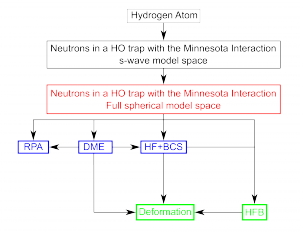User Tools
Sidebar
Computational Projects
As a starting point, we will ask every group of students to write a program (in the language of their choice) solving the Hartree-Fock equations in the spherical harmonic oscillator basis. To facilitate benchmarks, we chose to focus on systems of neutrons that are confined in a harmonic trap and are interacting via a schematic potential called the Minnesota potential. Spherical symmetry will be assumed throughout. Even this simplified system may require a significant effort, so we tried to make your life a little easier.
- We provide most of the necessary background about the harmonic oscillator in this document;
- We give you, without demonstration, the matrix elements of the kinetic energy operator (see the same document);
- Upon request, we can make available to you various Fortran subroutines giving the nodes and weights of the Gauss-Laguerre quadrature. As an illustration, this program illustrates the various possible techniques to integrate numerically $\int_{0}^{\infty} xe^{-x}dx = 1$
- We also provide DFT solvers that you can use as benchmarks.
And of course, we will be around to help you, so don't hesitate to ask if you have questions.
1) HF Problem in a Truncated Model Space
In a first step, we will solve the HF equations for the system of N neutrons in a trap interacting with the Minnesota potential in a restricted basis consisting of only l=0 states. This simplifies tremendously the calculation of two-body matrix elements. We broke down the problem into several simple steps that are explained in this document.
2) HF Problem in the Full Spherical Harmonic Oscillator Basis
Now that each group (hopefully) has a working HF code for the truncated S-wave model space model, we are ready to attack the general case. Since the generation of two-body matrix elements (TBMEs) is tedious for the general case, we have uploaded a F90 pack to do this for you, see here. We will give more explanations on how to use the code in the lectures. Finally, the following document outlines how the HF equations look in spherical symmetry for general model spaces, hf_fullspherical.pdf. We give below a description of what is contained in the files.
Single-particle files - The single-particle files are named spM.dat and spJ.dat for the M-scheme and coupled J scheme, respectively. The first line (starting with “Legend”) gives the meaning of the numbers
- For the M-scheme: counter $n\ l\ 2j\ 2m_j\ 2t_z$
- For the J-scheme: counter $n\ l\ 2j\ t_z\ 2n+l$
Interaction files - The interaction files are named VM-scheme.dat and VJ-scheme.dat, respectively (for the M-scheme and the J-scheme).
- For the M-scheme: $a\ b\ c\ d\ v_{abcd}$
- For the J-scheme: $t_z\ \pi\ 2J\ a\ b\ c\ d\ v_{abcd}$
where $\pi$ is the parity. In each case, the a, b, c, d numbers refer to the counters listed in the single-particle files.
3) Possible Extensions for Week 3 and Later
Upon completion, the (full) HF code that you have developed can be used to explore various other approximations to the many-body problem. The figure below shows some of the possible extensions, and how one could piece them together (like Lego pieces, ideally).
In this document, we explain in more details how to implement 3 of these extensions, namely (i) the solution of the HFB equations in spherical symmetry, (ii) the solution of the RPA equations in spherical symmetry, and (iii) the solutions of the deformed HF equations. When you are done with the full HF program, you should choose one of these problems and start working on it. We can provide benchmarks for the spherical HFB problem and the deformed HF, not yet for the RPA.
References
- S. K. Bogner, R. J. Furnstahl, H. Hergert, M. Kortelainen, P. Maris, M. Stoitsov, and J. P. Vary, Testing the density matrix expansion against ab initio calculations of trapped neutron drops, Phys. Rev. C 84, 044306 (2011)



